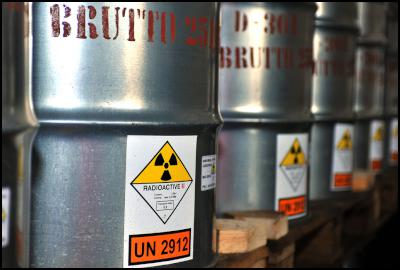Despite Price Dip, Uranium Demand, Production on the Rise
Despite Price Dip, Uranium Demand, Production Continues to Rise – UN Atomic Watchdog

Uranium ore is processed into a concentrate known as yellowcake and packed in special, tightly sealed steel drums similar in size to oil barrels. Photo: IAEA
10 September 2014 – A new report by the International Atomic Energy Agency (IAEA) published today found that demand for uranium, the raw material used to fuel nuclear power stations, will continue to rise, despite declining market prices since the Fukushima Daiichi Nuclear Power Plant accident in Japan in March 2011 and lower electricity demand as a result of the global economic crisis.
The Red Book, as the report is known, is a recognized global reference on uranium jointly prepared by the IAEA and the Nuclear Energy Agency of the Organisation for Economic Cooperation and Development (NEA/OECD).
It found an increase in uranium supply, exploration and production. Some seven per cent more uranium resources have been identified since the last report was published in 2012, adding almost 10 years to the existing resource base.
Global uranium production continued to increase between 2010 and 2012, albeit at a lower rate than in the previous two-year period. The growth in the resource base is mainly due to a 23 per cent increase in uranium exploration and mine development, which totalled $1.92 billion in 2012.
On the demand side, projections vary from region to region. While the Fukushima Daiichi nuclear accident resulted in a change of policies in many developed countries, nuclear capacity projections, notably in East Asia and non-European Union states on the European continent, continue to grow.
The Red Book projects that world nuclear electricity generating capacity by 2035 is expected to increase between 7 per cent on the low and 82 per cent on the high side. This is in line with the IAEA's most recent projections of between 8 and 88 per cent for the year 2030.
More than 20 countries around the globe produce uranium, with Kazakhstan, Canada and Australia as the largest producers, accounting for approximately 63 per cent of world production. The reported growth in production is mainly driven by Kazakhstan, with smaller additions in Australia, Brazil, China, Malawi, Namibia, Niger, Ukraine and the United States.
The continued robust demand for the resource has led to future plans for mining operations in new countries including Botswana, Tanzania and Zambia. And to minimise the social and environmental impacts, efforts are being made to develop safe and well-regulated operations.
The new report provides analyses from 45 countries in order to address questions on global uranium exploration, resources, production and reactor-related requirements. It also offers updated information on uranium production centres and mine development plans, as well as projections of nuclear generating capacity and reactor-related requirements through 2035.
ENDS


 Pacific Islands FFA: Ten Years Together - Celebrating Regional Solidarity Through The NTSA
Pacific Islands FFA: Ten Years Together - Celebrating Regional Solidarity Through The NTSA ITUC: The Greatest Threat To Democracy In 80 Years - Stop The Billionaire Coup
ITUC: The Greatest Threat To Democracy In 80 Years - Stop The Billionaire Coup Save The Children: A Third Of 5-Year-Olds Will Be Spared Unprecedented Lifetime Exposure To Dangerous Heat If World Meets 1.5°C Temperature
Save The Children: A Third Of 5-Year-Olds Will Be Spared Unprecedented Lifetime Exposure To Dangerous Heat If World Meets 1.5°C Temperature Access Now: NSO To Pay $168 Million In Damages To WhatsApp For Pegasus Spyware Hacking
Access Now: NSO To Pay $168 Million In Damages To WhatsApp For Pegasus Spyware Hacking NIWA: New Study Reveals Climate Change Is Already Impacting The Andes
NIWA: New Study Reveals Climate Change Is Already Impacting The Andes Friends of Tonga: Bilingual Reading Apps Aim To Boost Literacy In Tonga
Friends of Tonga: Bilingual Reading Apps Aim To Boost Literacy In Tonga